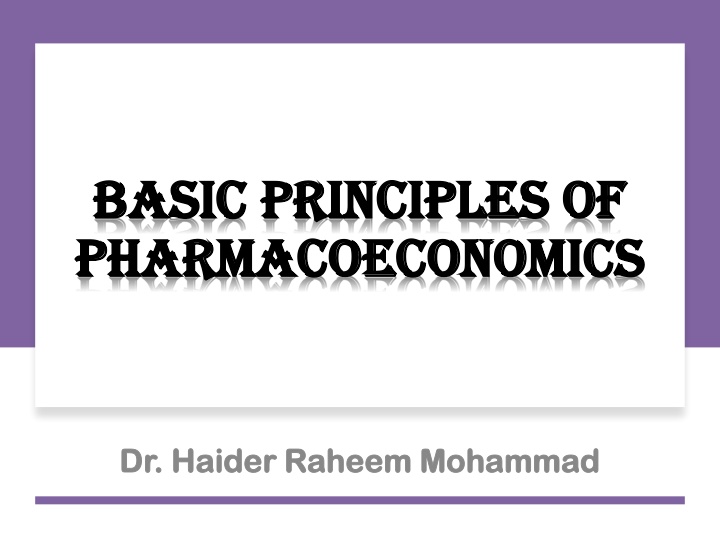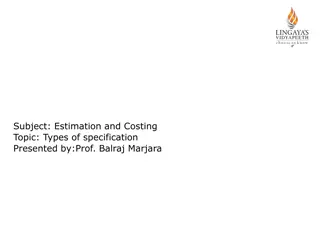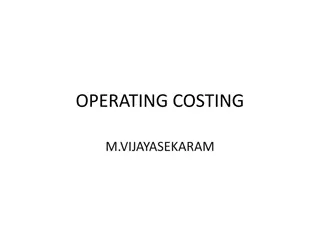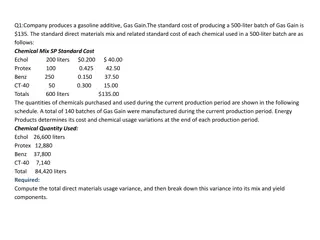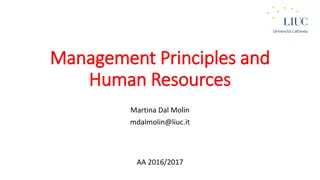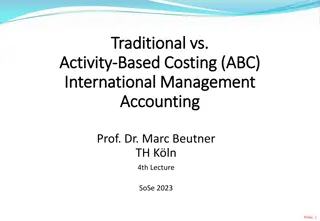Basic Principles of Pharmacoeconomics Costing Terms
According to economic theory, the true cost of a resource is its opportunity cost, not necessarily the amount of money exchanged. Learn about the differences between price, cost, and charges in healthcare economics, including cost categorization in pharmacoeconomics.
Download Presentation

Please find below an Image/Link to download the presentation.
The content on the website is provided AS IS for your information and personal use only. It may not be sold, licensed, or shared on other websites without obtaining consent from the author.If you encounter any issues during the download, it is possible that the publisher has removed the file from their server.
You are allowed to download the files provided on this website for personal or commercial use, subject to the condition that they are used lawfully. All files are the property of their respective owners.
The content on the website is provided AS IS for your information and personal use only. It may not be sold, licensed, or shared on other websites without obtaining consent from the author.
E N D
Presentation Transcript
Basic Principles of Basic Principles of Pharmacoeconomics Pharmacoeconomics Dr. Haider Raheem Mohammad Dr. Haider Raheem Mohammad
Costing terms According to economic theory, the true cost of a resource is its opportunity cost the value of the best-forgone option or the next best option not necessarily the amount of money that changes hands. Resources committed to one product or service cannot be used for other products or services (opportunities). For example, if volunteers are used to help staff a new clinic, even though no money changes hands (i.e., volunteers are not paid), there is an opportunity cost associated with their help because they could be providing other services if they were not helping at the new clinic. Another example is if the new clinic required a part-time pharmacist and a currently employed pharmacist was asked to fill in at the clinic as part of his or her duties (instead of hiring a new part-time pharmacist for the clinic).
Costing terms The price or the amount that is charged to a payer is not necessarily synonymous with the cost of the product or service. For example, if a hospital system wanted to calculate how much it cost to treat a patient with a specific diagnosis, there may be a substantial difference in what the total cost is to the hospital when compared with the amount the hospital charges the payer and what is actually collected from the payer after allowable amounts are factored in.
Costing terms Think of these differences as similar to the new car market. There is a cost to the car manufacturer to produce a car, a sticker price, which is the suggested price of the car (higher than the cost to produce the car), and the amount paid by the average car buyer (usually lower than the sticker price, which is good news for the buyer, but is hopefully higher than the cost to produce the car, which is good news for the manufacturer). These, in turn, are similar to the actual cost of a hospital to provide a service, the charge billed to the payer (third-party insurance payer, patient payer, or a combination), and the allowable charge or reimbursed amount paid by the payer(s).
Cost categorization In the 1980s and 1990s, most textbooks categorized pharmacoeconomic (PE)-related costs into four types: direct medical costs, direct nonmedical costs, indirect costs, and intangible costs (Table 2.1). These terms are not used consistently in the literature, and it has been noted that the economic term indirect costs, which refers to a loss of productivity, might be confused with the accounting definition of indirect costs, which is used to assign overhead. An alternative method of categorization has been recently proposed by Drummond et al. that includes the following four categories: health care sector costs, costs to other sectors, patient and family costs, and productivity costs.
Direct medical costs Direct medical costs are the most obvious costs to measure. These are the medically related inputs used directly to provide the treatment. Examples of direct medical costs include the costs associated with the pharmaceuticals, diagnostic tests, physician visits, pharmacist visits, emergency hospitalizations. department visits, and For chemotherapy treatment, for example, direct medical costs may include the chemotherapy products themselves, other medications given to reduce side effects of the chemotherapy, intravenous supplies, laboratory tests, clinic costs, and physician visits.
Direct nonmedical costs Direct nonmedical costs are costs to patients and their families that are directly associated with treatment but are not medical in nature. Examples of direct nonmedical costs include the cost of traveling to and from the physician s office, clinic, or the hospital; child care services for the children of a patient; and food and lodging required for the patients and their families during out-of-town treatment. For the chemotherapy treatment, patients may have increased travel costs related to traveling to the clinic or hospital. They may also have to hire a babysitter for the time they are undergoing treatment.
Indirect costs Indirect costs involve the costs that result from the loss of productivity because of illness or death. Indirect benefits, which are savings from avoiding indirect costs, are the increased earnings or productivity gains that occur because of the medical product or intervention. In the chemotherapy example, some indirect costs result from time the patient takes off from work to receive treatment or reduced productivity because of the effects of the disease or its treatment.
Intangible costs Intangible costs include the costs of pain, suffering, anxiety, or fatigue that occur because of an illness or the treatment of an illness. Intangible benefits, which are avoidance or alleviation of intangible costs, are benefits that result from a reduction in pain and suffering related to a product or intervention. It is difficult to measure or place a monetary value on these types of costs. In the example of chemotherapy, nausea and fatigue are common intangible costs of treatment.
Alternative method of categorization As mentioned, an alternative method of categorizing costs has recently been proposed by Drummond et al. The first category is health care sector costs, which include medical resources consumed by health care entities. These types of costs are similar to the definition of direct medical costs but do not include direct medical costs paid for by the patient (e.g., deductibles, co-payments) or other non health care entities. The second category is other sector costs. Some diseases and their treatment impact other non health care sectors, such as housing, homemaker services, and educational services. One example often noted is that when measuring resources used and savings incurred by the treatment of patients with schizophrenia, researchers should consider the impact on other sectors, including public assistance and the prison system.
Alternative method of categorization The third category is patient and family costs. This categorization includes costs to the patient and his or her family without regard to whether the costs are medical or nonmedical in nature. The fourth category is termed productivity costs and is analogous to the economic term indirect costs but has the advantage of not being confused with the accounting term with the same name. Drummond et al. advise against using the term intangible costs because they are not costs (i.e., resources denied other uses) and they are not strictly intangible as they are often measured and valued, through the utility or willingness-to-pay approach.
Perspective To determine what costs are important to measure, the perspective of the study must be determined. Perspective is an economic term that describes whose costs are relevant based on the purpose of the study. Conventional economic theory suggests that the most appropriate and comprehensive perspective is that of society. Societal costs include costs to the insurance company, costs to the patient, costs to the provider/institution, other sector costs, and indirect costs because of the loss of productivity. Although this may be the most appropriate perspective according to economic theory, it is not the most commonly seen in the PE literature because it is difficult and time- consuming to estimate all of these cost components. In many cases, researchers are not interested in the overall costs of each treatment alternative; instead, they are interested in the differences in costs between two alternatives, and if they do not expect differences in any costs except for direct medical costs, measurement of other types of costs would not be relevant.
Timing adjustments for costs Bringing past costs to the present: standardization of costs When costs are estimated from information collected for more than 1 year before the study, adjustment of costs is needed; this is also referred to as standardization of costs. If you compared costs for patients who received treatment in 2005 with those for patients who received treatment in 2010, the comparison of resources used would not be a fair comparison because treatment costs tend to go up each year; so patients who received the same treatment in 2005 would have lower costs than those who received the treatment in 2010. Adjustment of the 2005 costs to the amount they would have cost in 2010 is needed before a direct (fair) comparison can be made between these groups.
Table 2.2 illustrates an example of adjustment using this first method to estimate the treatment costs for a mild infection. These costs include two office visits, one laboratory service, and a prescription for an antibiotic. Table 2.2 Example of standardization: units multiplied by costs
Another method used to standardize past costs is to multiply all of the costs from the year the data were collected by the medical inflation rate for that year (Table 2.3). Medical Consumer Price Index (MCPI) inflation rates can be found at the Bureau of Labor Statistics s website (www.bls.gov) and have been between 3% and 4% each year since 2005. Table 2.3 Example of standardization: using medical consumer price index (MCPI) inflation rates
Bringing future costs (benefits) to the present: discounting If costs are estimated based on dollars spent or saved in future years, another type of modification, called discounting, is needed. There is a time value associated with money. People (and businesses) prefer to receive money today rather than at a later time. Money promised in the future, similar to health care savings promised in the future, is valued at a lower rate than money (savings) received today. Modifications for this time value are estimated using a discount rate. The discount rate approximates the cost of capital by taking into account the interest rates of borrowed money. From this parameter, the present value (PV) of future expenditures and savings can be calculated. The discount rate generally accepted for health care interventions is between 3% and 5%, but it is recommended that a comparison of results be conducted using high and low estimates of various discount rates. Varying these discount rates is an example of a sensitivity analysis.
The discount factor is equal to 1/(1 + r)t, where r is the discount rate and t is the number of years in the future that the cost or savings occur. For example, if the expenses of cancer treatment for the next 3 years are $5,000 for year 1, $3,000 for year 2, and $4,000 for year 3, discounting should be used to determine total expenses in PV terms. If one assumes that the expenses occur at the beginning of each year, then first-year costs are not discounted (see Table 2.4). Table 2.4 Example of discounting: costs assessed at beginning of each yeara
It is equally acceptable to assume that expenses occur at the end of the first year (12 months later), and therefore, they are discounted (see Table 2.5). Table 2.5 Example of discounting: costs assessed at end of each yeara Another example looks at discounting both the estimated costs and estimated savings over 3 years of operating a new asthma clinic (using a 3% discount rate and no discounting for first-year costs and savings).
Average versus marginal or incremental costs When deciding between medication A and medication B, a clinician would find it useful to know the estimated difference in costs and the estimated difference in outcomes between the medications to determine whether added benefits outweigh the added costs. Therefore, when comparing the costs of options, it is important to look at the change in costs. The terms marginal costs and incremental costs are often used interchangeably to refer to this change or difference between alternatives. In clinical practice, a realistic option may be to compare a new treatment with a standard treatment; thus, the difference in these costs is of interest to the decision maker. Therefore, the calculation of the change in costs divided by the change in outcomes should be used. The result of this calculation is termed the incremental cost- effectiveness ratio (ICER), and it can be very different from comparing the average costs of the options or alternatives, especially when the difference in outcomes is small.
Table 2.6 shows an example of the disparity in results when calculating average costs per outcome compared with calculating incremental costs per outcome. Table 2.6 Comparing average and incremental cost ratios
Average versus marginal or incremental costs Treatment B costs only $125 more per patient than treatment A ($450 versus $325, respectively), yet the cost per additional (incremental) success (the ICER) is $3,125. Some find it easier to understand this concept if they calculate this ratio another way. If a clinician is faced with the choice of treating 100 patients with treatment A (100 patients $325 per patient = $32,500) or 100 patients with treatment B (100 patients $450 = $45,000), it would cost $12,500 ($45,000 versus $32,500) more to treat 100 patients with treatment B. Of the 100 patients treated with treatment A, 87 would have a successful outcome, but 91 of the 100 patients treated with treatment B would have a successful outcome (four extra successes). Therefore, it is estimated that it costs $12,500 more to treat 100 patients with treatment B in order to achieve four extra successes (or as before $3,125 per extra success).
Micro-costing The most precise method of estimating hospital costs is micro- costing. Micro-costing involves collecting information on resource use for each component of an intervention to estimate and compare alternative interventions. This usually entails a review of patients hospital records to determine what specific services (e.g., medications, laboratory services, procedures) were used and to assign a cost to each service. Records are kept for each service to determine how much to charge the payers (patient and third-party payers) for each hospital stay. To make a profit, the true costs of providing these services need to be lower than the amount of reimbursement from the payers.
Cost of illness Cost-of-illness (COI) analysis measures the economic burden of disease and illness on society. COI analyses are used to aid in policy making; resource allocation that is, prioritizing resource use for disease treatment and prevention and as baseline research from which to determine the potential benefit of new therapies. Approaches There are two approaches to conducting COI analyses, the prevalence-based approach and the incidence-based approach. The prevalence-based approach considers the cost of disease within a specified time period. The prevalence-based approach is most appropriate for diseases or illnesses that are measured within the time period of analysis and that do not change much over time (e.g., migraine) or acute diseases (e.g., asthma, eczema).
Cost of illness This is in contrast to the incidence-based approach, which calculates the lifetime costs of disease. This approach is most appropriate for chronic diseases, such as hypertension, or diseases that take a long time to progress, such as diabetes. Methods A micro-costing method has been used in many studies to examine COI. The direct costs included in this method typically comprise out-of-pocket expenses for noninsured items (over-the-counter medications, visits to out-of-plan laundry/clothing, and specialty prescription medications and clinic visits determined from insurance claims databases. health and practitioners, co-payments items) for
Atopic dermatitis as an example of cost of illness studies Direct and indirect costs for atopic dermatitis (AD) have been measured in various countries and are substantial from both a patient and a societal perspective. The direct costs have been reported to range from $71 to $2,559 per patient per year. This variation in cost is due to differences in study methodology as well as differences in health care systems of the various countries. Most of the costs of AD consist of indirect costs associated with time lost from work, lifestyle changes, and non-traditional or over-the-counter treatments for AD. The financial burden on the health care system and on society is expected to grow because the prevalence of the disease is increasing. Typically, outpatient visits and medications composed the majority of direct costs, ranging from approximately 62% to >90%. The distribution of AD-associated direct costs from Fivenson et al is shown in Figure 2.1.
Figure 2.1 Distribution of atopic dermatitis-associated direct costs in a U.S. health plan. In those studies that examined indirect costs (e.g., the patient out-of- pocket costs for co-pays, medications, household items, loss of productivity) they made up substantial percentages of the total, e.g., 36% or 73%. Several studies showed increasing costs with worsening disease severity in adults. Indirect costs also increased by worsening disease severity by more than twofold to threefold to as much as almost tenfold.
Therapy-specific cost Several studies have compared the cost of different uses of topical corticosteroids (TCS) vs. topical immunomodulators (i.e., pimecrolimus and tacrolimus) and of the topical immunomodulators against each other. The authors noted a wide variation in price and product availability, with the lowest price being generic hydrocortisone ( 0.60 [approximately US$1.09]) to the highest at that time being mometasone furoate (Elocon) of 4.88 (approximate US$8.80 equivalent). Clinical data show that topical immunomodulators are effective in AD, yet do not cause the significant adverse effects associated with TCS. Delea and colleagues retrospectively compared 157 pimecrolimus patients with 157 tacrolimus patients previously receiving TCS in a large claims database of managed care patients and AD-related follow-up costs. Patients in the pimecrolimus group had fewer pharmacy claims for TCS (mean 1.37 vs. 2.04, P = 0.021); this occurred primarily in the high-potency topical corticosteroid category.
